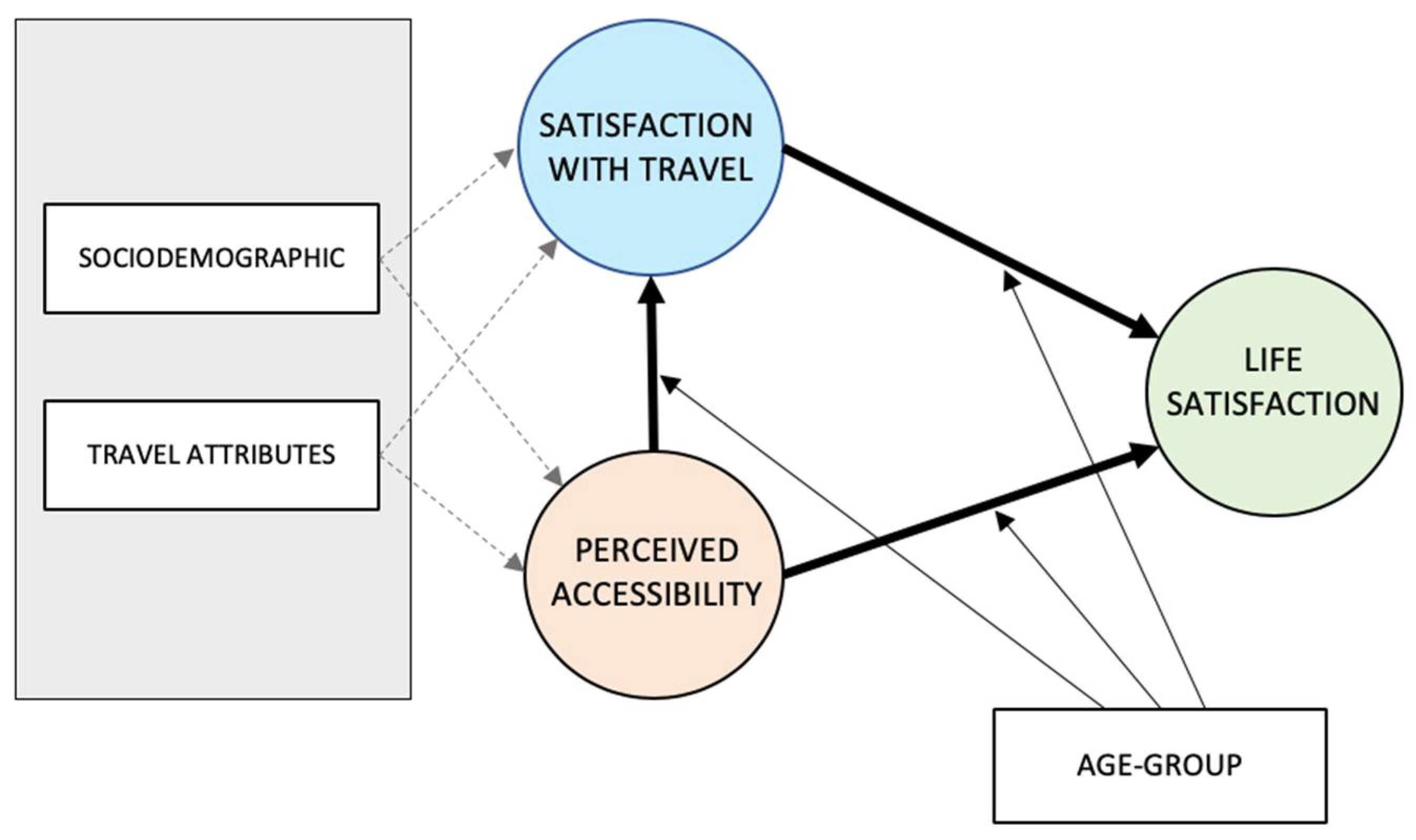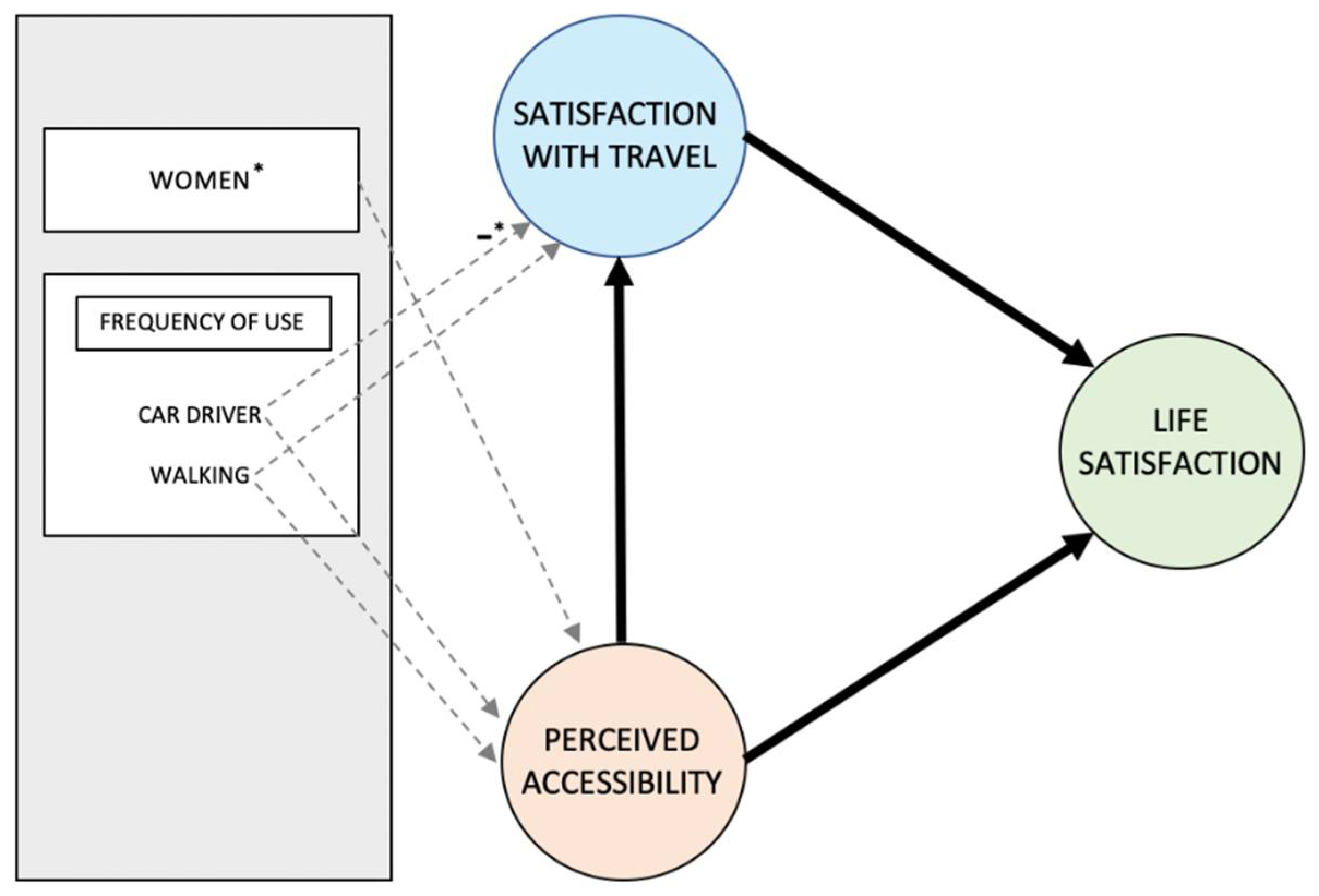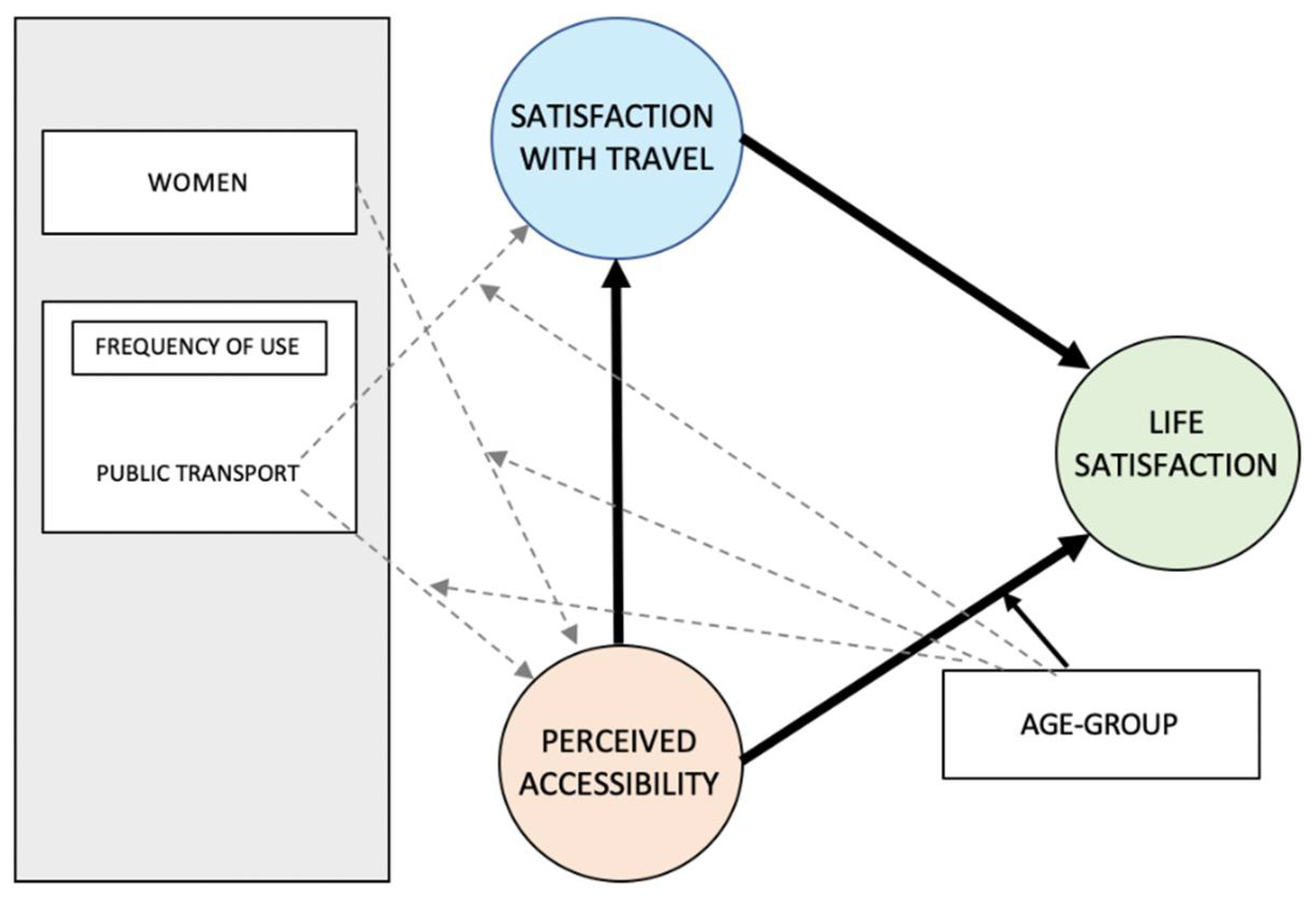Perceived Accessibility, Satisfaction with Daily Travel, and Life Satisfaction among the Elderly
Abstract
1. Introduction
1.1. Daily Travel
1.2. Theoretical Framework
1.3. The Present Study
2. Method
2.1. Participants
2.2. Procedure and Measures
2.3. Analyses
2.4. Ethical Statement
3. Results
3.1. Travel Mode Use
3.2. PLS-SEM
3.2.1. Reliability and Validity of the Latent Constructs
3.2.2. Testing the Structural Model
3.2.3. Testing Moderation by Age Group
3.2.4. Comparisons of Means Across the Age Brackets for PAC, STS, and LS
4. Discussion
5. Conclusions
Author Contributions
Funding
Conflicts of Interest
References
- United Nations, Department of Economic and Social Affairs, Population Division. World Population Ageing 2015 (ST/ESA/SER. A/390); United Nations: New York, NY, USA, 2015. [Google Scholar]
- Cohen, S.A.; Gössling, S. A darker side of hypermobility. Environ. Plan. A Econ. Space 2015, 47, 1661–1679. [Google Scholar] [CrossRef]
- Larsen, J.; Axhausen, K.W.; Urry, J. Geographies of social networks: Meetings, travel and communications. Mobilities 2006, 1, 261–283. [Google Scholar] [CrossRef]
- Preston, J.; Rajé, F. Accessibility, mobility and transport-related social exclusion. J. Transp. Geogr. 2007, 15, 151–160. [Google Scholar] [CrossRef]
- Stanley, J.K.; Hensher, D.A.; Stanley, J.R.; Vella-Brodrick, D. Mobility, social exclusion and well-being: Exploring the links. Transp. Res. Part A Policy Pract. 2011, 45, 789–801. [Google Scholar] [CrossRef]
- Lyubomirsky, S. The How of Happiness: A Scientific Approach to Getting the Life You Want; Penguin: New York, NY, USA, 2008. [Google Scholar]
- Nordbakke, S. Mobilitet Blant Yngre, Eldre og Funksjonshemmede-bilens Rolle; Transportøkonomisk Institutt: Oslo, Norway, 2006. [Google Scholar]
- European Road Safety Observatory. Older Drivers 2015; European Commission: Brussels, Belgium, 2015. [Google Scholar]
- Siren, A.; Hakamies-Blomqvist, L. Private car as the grand equaliser? Demographic factors and mobility in Finnish men and women aged 65+. Transp. Res. Part F Traffic Psychol. Behav. 2004, 7, 107–118. [Google Scholar] [CrossRef]
- Siren, A.; Haustein, S. Baby boomers’ mobility patterns and preferences: What are the implications for future transport? Transp. Policy 2013, 29, 136–144. [Google Scholar] [CrossRef]
- Su, F.; Bell, M.G. Travel differences by gender for older people in London. Res. Transp. Econ. 2012, 34, 35–38. [Google Scholar] [CrossRef]
- Edwards, J.D.; Bart, E.; O’Connor, M.L.; Cissell, G. Ten years down the road: Predictors of driving cessation. Gerontologist 2009, 50, 393–399. [Google Scholar] [CrossRef] [PubMed]
- Cui, J.; Loo, B.P.; Lin, D. Travel behaviour and mobility needs of older adults in an ageing and car-dependent society. Int. J. Urban Sci. 2017, 21, 109–128. [Google Scholar] [CrossRef]
- Boschmann, E.E.; Brady, S.A. Travel behaviors, sustainable mobility, and transit-oriented developments: A travel counts analysis of older adults in the Denver, Colorado metropolitan area. J. Transp. Geogr. 2013, 33, 1–11. [Google Scholar] [CrossRef]
- Hensher, D.A. Some insights into the key influences on trip-chaining activity and public transport use of seniors and the elderly. Int. J. Sustain. Transp. 2007, 1, 53–68. [Google Scholar] [CrossRef]
- Giuliano, G.; Hu, H.H.; Lee, K. Travel Patterns of the Elderly: The Role of Land Use (No. FHWA/CA/OR-2003/06); METRANS Transportation Center: Los Angeles, CA, USA, 2003. [Google Scholar]
- Currie, G.; Delbosc, A. Exploring public transport usage trends in an ageing population. Transportation 2010, 37, 151–164. [Google Scholar] [CrossRef]
- Ryan, J.; Wretstrand, A.; Schmidt, S.M. Exploring public transport as an element of older persons’ mobility: A Capability Approach perspective. J. Transp. Geogr. 2015, 48, 105–114. [Google Scholar] [CrossRef]
- Hess, D.B. Walking to the bus: Perceived versus actual walking distance to bus stops for older adults. Transportation 2012, 39, 247–266. [Google Scholar] [CrossRef]
- Cao, X.; Mokhtarian, P.L.; Handy, S.L. Neighborhood design and the accessibility of the elderly: An empirical analysis in Northern California. Int. J. Sustain. Transp. 2010, 4, 347–371. [Google Scholar] [CrossRef]
- Pucher, J.; Buehler, R.; Merom, D.; Bauman, A. Walking and cycling in the United States, 2001–2009: Evidence from the National Household Travel Surveys. Am. J. Public Health 2011, 101, 310–317. [Google Scholar] [CrossRef]
- Pucher, J.; Dijkstra, L. Promoting safe walking and cycling to improve public health: Lessons from the Netherlands and Germany. Am. J. Public Health 2003, 93, 1509–1516. [Google Scholar] [CrossRef]
- Böcker, L.; van Amen, P.; Helbich, M. Elderly travel frequencies and transport mode choices in Greater Rotterdam, the Netherlands. Transportation 2017, 44, 831–852. [Google Scholar] [CrossRef]
- Friman, M.; Fujii, S.; Ettema, D.; Gärling, T.; Olsson, L.E. Psychometric analysis of the satisfaction with travel scale. Transp. Res. Part A Policy Pract. 2013, 48, 132–145. [Google Scholar] [CrossRef]
- Ettema, D.; Gärling, T.; Olsson, L.E.; Friman, M. Out-of-Home Activities, Daily Travel, and Subjective Well-Being. Transp. Res. Part A Policy Pract. 2010, 44, 723–732. [Google Scholar] [CrossRef]
- De Vos, J.; Schwanen, T.; Van Acker, V.; Witlox, F. Travel and subjective well-being: A focus on findings, methods and future research needs. Transp. Rev. 2013, 33, 421–442. [Google Scholar] [CrossRef]
- Graham, H.; de Bell, S.; Flemming, K.; Sowden, A.; White, P.; Wright, K. Older people’s experiences of everyday travel in the urban environment: A thematic synthesis of qualitative studies in the United Kingdom. Ageing Soc. 2018, 1–27. [Google Scholar] [CrossRef]
- Gabriel, Z.; Bowling, A. Quality of life from the perspectives of older people. Ageing Soc. 2004, 24, 675–691. [Google Scholar] [CrossRef]
- Musselwhite, C.; Haddad, H. Exploring older drivers perceptions of driving. Eur. J. Ageing 2010, 7, 181–188. [Google Scholar] [CrossRef]
- Ziegler, F.; Schwanen, T. ‘I like to go out to be energised by different people’: An exploratory analysis of mobility and wellbeing in later life. Ageing Soc. 2011, 31, 758–781. [Google Scholar] [CrossRef]
- Lättman, K.; Friman, M.; Olsson, L.E. Perceived accessibility of public transport as a potential indicator of social inclusion. Soc. Incl. 2016, 4, 36–45. [Google Scholar] [CrossRef]
- Banister, D.; Bowling, A. Quality of life for the elderly: The transport dimension. Transp. Policy 2004, 11, 105–115. [Google Scholar] [CrossRef]
- Nordbakke, S.; Schwanen, T. Well-being and mobility: A theoretical framework and literature review focusing on older people. Mobilities 2014, 9, 104–129. [Google Scholar] [CrossRef]
- Nordbakke, S.; Schwanen, T. Transport, unmet activity needs and wellbeing in later life: Exploring the links. Transportation 2015, 42, 1129–1151. [Google Scholar] [CrossRef]
- Enam, A.; Konduri, K.C.; Eluru, N.; Ravulaparthy, S. Relationship between well-being and daily time use of elderly: Evidence from the disabilities and use of time survey. Transportation 2018, 45, 1783–1810. [Google Scholar] [CrossRef]
- Ryan, J.; Wretstrand, A. What’s mode got to do with it? Exploring the links between public transport and car access and opportunities for everyday activities among older people. Travel Behav. Soc. 2019, 14, 107–118. [Google Scholar] [CrossRef]
- Van der Vlugt, A.L.; Curl, A.; Wittowsky, D. What about the people? Developing measures of perceived accessibility from case studies in Germany and the UK. Appl. Mobilities 2019, 1–21. [Google Scholar] [CrossRef]
- Lättman, K.; Olsson, L.E.; Friman, M. A new approach to accessibility–Examining perceived accessibility in contrast to objectively measured accessibility in daily travel. Res. Transp. Econ. 2018, 69, 501–511. [Google Scholar] [CrossRef]
- Ettema, D.; Gärling, T.; Eriksson, L.; Friman, M.; Olsson, L.E.; Fujii, S. Satisfaction with travel and subjective well-being: Development and test of a measurement tool. Transp. Res. Part F Traffic Psychol. Behav. 2011, 14, 167–175. [Google Scholar] [CrossRef]
- Hair, J.F.; Sarstedt, M.; Ringle, C.M.; Gudergan, S.P. Advanced Issues in Partial Least Squares Structural Equation Modeling (PLS-SEM); Sage: Thousand Oaks, CA, USA, 2017. [Google Scholar]
- Hair, J.F.; Risher, J.J.; Sarstedt, M.; Ringle, C.M. When to use and how to report the results of PLS-SEM. Eur. Bus. Rev. 2019, 31, 2–24. [Google Scholar] [CrossRef]
- Henseler, J.; Ringle, C.M.; Sarstedt, M. A new criterion for assessing discriminant validity in variance-based structural equation modeling. J. Acad. Mark. Sci. 2015, 43, 115–135. [Google Scholar] [CrossRef]
- Fornell, C.; Larcker, D.F. Evaluating structural equation models with unobservable variables and measurement error. J. Mark. Res. 1981, 18, 39–50. [Google Scholar] [CrossRef]
- Hair, J.F.; Ringle, C.M.; Sarstedt, M. Partial least squares structural equation modeling: Rigorous applications, better results and higher acceptance. Long Range Plan. 2013, 46, 1–12. [Google Scholar] [CrossRef]
- Henseler, J.; Hubona, G.; Ray, P.A. Using PLS path modeling in new technology research: Updated guidelines. Ind. Manag. Data Syst. 2016, 116, 2–20. [Google Scholar] [CrossRef]
- Haustein, S.; Siren, A.K.; Framke, E.; Bell, D.; Pokriefke, E.; Alauzet, A.; Marin-Lamellet, C.; Armoogum, J.; O’Neill, D. Demographic Change and Transport; CONSOL Report; European Commission: Kongens Lyngby, DE, USA, 2013. [Google Scholar]
- Schorr, A.V.; Iecovich, E.; Alfasi, N.; Shamai, S. Socio-Spatial Integration of Older Adults in Four Types of Residential Environments in Israel. J. Appl. Gerontol. 2017, 36, 1243–1271. [Google Scholar] [CrossRef]
- Marquez, L.; Poveda, J.C.; Vega, L.A. Factors affecting personal autonomy and perceived accessibility of people with mobility impairments in an urban transport choice context. J. Transp. Health 2019, 14, 100583. [Google Scholar] [CrossRef]
- Luiu, C.; Tight, M.; Burrow, M. Factors preventing the use of alternative transport modes to the car in later life. Sustainability 2018, 10, 1982. [Google Scholar] [CrossRef]
- Lättman, K.; Friman, M.; Olsson, L.E. Restricted car-use and perceived accessibility. Unpublished work.



| Age Groups | Year of Birth | Age in 2019 |
|---|---|---|
| Pre-retirement | 1958–1954 | 60–64 |
| Early retirement | 1953–1949 | 65–69 |
| Young old | 1948–1944 | 70–74 |
| Old | 1943–1939 | 75–79 |
| Old with high longevity | 1938– | 80– |
| Descriptive | Age Group | |||||
|---|---|---|---|---|---|---|
| Pre-Retirement | Early Retirement | Young Old | Old | Old with High Longevity | ||
| Age | (60–64) | (65–69) | (70–74) | (75–79) | (80–) | |
| Number of participants (N) | 675 | 536 | 587 | 318 | 306 | |
| Women (%) | 44.9 | 52.1 | 47.4 | 51.6 | 56.9 | |
| Employment status (%) | ||||||
| Working full time | 53.0 | 11.0 | 1.7 | 0.3 | - | |
| Working part time | 10.0 | 5.4 | 3.1 | 0.9 | 2.6 | |
| Retired | 30.5 | 82.3 | 94.0 | 98.0 | 97.4 | |
| Other not specified | 6.5 | 1.3 | 1.2 | 0.6 | - | |
| PAC Item | Wording |
|---|---|
| 1 | Considering how I travel today, it’s easy to do (daily) activities. |
| 2 | Considering how I travel today, I’m able to live my life as I want to. |
| 3 | Considering how I travel today, I’m able to do all the activities I prefer to do. |
| 4 | Considering how I travel today, access to my preferred activities is satisfying. |
| Cognitive Quality Evaluation | ||||||||
|---|---|---|---|---|---|---|---|---|
| “Think about your daily travel. How do you experience your daily travel in general? My trips…” | ||||||||
| work poorly, are of a low standard, the worst imaginable. | −3 | −2 | −1 | 0 | 1 | 2 | 3 | work well, are of a high standard, the best imaginable. |
| Affective Evaluation of Feelings of Boredom vs. Enthusiasm | ||||||||
| “Think about your daily travel. How do you experience your daily travel in general? I feel …” | ||||||||
| very bored, tired, fed-up. | −3 | −2 | −1 | 0 | 1 | 2 | 3 | very enthusiastic, alert, engaged. |
| Affective Evaluation of Feelings of Stress vs. Relaxation | ||||||||
| “Think about your daily travel. How do you experience your daily travel in general? I feel …” | ||||||||
| very stressed, worried, hurried. | −3 | −2 | −1 | 0 | 1 | 2 | 3 | very relaxed, calm, confident. |
| Mode | Pre-Retirement | Early Retirement | Young Old | Old | Old with High Longevity | Group Comparisons Using Kruskal–Wallis ANOVAs (H) |
|---|---|---|---|---|---|---|
| Car as driver | 55.5 | 56.5 | 55.0 | 47.5 | 36.1 | H = 55.83, p < 0.001 |
| Car as passenger | 16.9 | 21.8 | 19.7 | 11.9 | 13.8 | H = 27.11, p < 0.001 |
| Public transport | 34.9 | 36.6 | 31.4 | 33.3 | 36.2 | H = 2.76, p = 0.593 |
| Bicycle | 22.6 | 24.0 | 20.8 | 15.3 | 12.3 | H = 92.23, p < 0.001 |
| Walking | 30.5 | 35.5 | 32.2 | 27.5 | 29.2 | H = 16.86, p = 0.002 |
| Other * | 3.4 | 1.1 | 1.4 | 1.7 | 2.8 |
| Direct Effects | β | t | p |
|---|---|---|---|
| Bicycle → PAC | 0.032 | 1.630 | 0.103 |
| Bicycle → STS | 0.001 | 0.051 | 0.969 |
| Car as driver → PAC | 0.137 | 5.946 | <0.001 |
| Car as driver → STS | −0.039 | 1.843 | 0.065 |
| Car as passenger → PAC | −0.025 | 1.102 | 0.270 |
| Car as passenger → STS | −0.009 | 0.471 | 0.638 |
| PAC → LS | 0.307 | 11.751 | <0.001 |
| PAC → STS | 0.394 | 18.525 | <0.001 |
| Public transport → PAC | −0.021 | 0.913 | 0.361 |
| Public transport → STS | −0.026 | 1.167 | 0.243 |
| STS → LS | 0.132 | 5.612 | <0.001 |
| Walking → PAC | 0.074 | 3.254 | 0.001 |
| Walking → STS | 0.095 | 4.688 | <0.001 |
| Women → PAC | 0.040 | 1.808 | 0.071 |
| Women → STS | −0.024 | 1.203 | 0.229 |
| Construct | Age Group | ||||
|---|---|---|---|---|---|
| Pre-Retirement | Early Retirement | Young Old | Old | Old with High Longevity | |
| Perceived Accessibility | 5.66(1.2) | 5.80(1.2) | 5.78(1.2) | 5.71(1.3) | 5.56(1.3) |
| Satisfaction with Travel (1–7) | 5.01(1.1) | 5.20(1.1) | 5.27(1.0) | 5.20(1.1) | 5.14(1.2) |
| Life Satisfaction (1–7) | 5.78(1.0) | 5.93(0.9) | 5.89(0.9) | 5.95(0.9) | 5.94(0.9) |
© 2019 by the authors. Licensee MDPI, Basel, Switzerland. This article is an open access article distributed under the terms and conditions of the Creative Commons Attribution (CC BY) license (http://creativecommons.org/licenses/by/4.0/).
Share and Cite
Lättman, K.; Olsson, L.E.; Friman, M.; Fujii, S. Perceived Accessibility, Satisfaction with Daily Travel, and Life Satisfaction among the Elderly. Int. J. Environ. Res. Public Health 2019, 16, 4498. https://doi.org/10.3390/ijerph16224498
Lättman K, Olsson LE, Friman M, Fujii S. Perceived Accessibility, Satisfaction with Daily Travel, and Life Satisfaction among the Elderly. International Journal of Environmental Research and Public Health. 2019; 16(22):4498. https://doi.org/10.3390/ijerph16224498
Chicago/Turabian StyleLättman, Katrin, Lars E. Olsson, Margareta Friman, and Satoshi Fujii. 2019. "Perceived Accessibility, Satisfaction with Daily Travel, and Life Satisfaction among the Elderly" International Journal of Environmental Research and Public Health 16, no. 22: 4498. https://doi.org/10.3390/ijerph16224498
APA StyleLättman, K., Olsson, L. E., Friman, M., & Fujii, S. (2019). Perceived Accessibility, Satisfaction with Daily Travel, and Life Satisfaction among the Elderly. International Journal of Environmental Research and Public Health, 16(22), 4498. https://doi.org/10.3390/ijerph16224498








